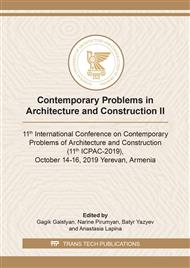p.121
p.129
p.136
p.141
p.146
p.153
p.158
p.163
p.170
New Energy Efficient Technology of Cellular Glass
Abstract:
On the base of volcanic glass - perlite, the energy-efficient technology of cellular glass for heat-insulating purposes has been developed. Compositions of nanosized modifier and redox gas formers were developed by the method of experimental-statistical modeling and optimization of probability parameters, allowing to obtain cellular glasses with low average density and almost closed porosity in a single technological process at technologically acceptable temperatures. In the production of cellular glasses (foam glass) of new generation, based on natural glassy rocks of silicate and aluminosilicate composition modified with sodium hydroxide, in the presence of water and gas-forming additives, during mixing and sintering, the components react at the nanoscale level to form glass under low softening temperature and sufficient quantity of foam stabilizers. The main scientific results - the use of nanotechnological modification of amorphous silicate and aluminosilicate rocks in the technology of cellular glass for construction and technical purposes, the development of compositions and method for the production of cellular glass using energy-saving technology with the following performance parameters: average density of 115...250kg/m3, coefficient of thermal conductivity 0,051...0.075W/(m•K), water absorption 1.6...4.0%, compressive strength 0.14...4.20 MPa, hydrolytic glass class I...III.
Info:
Periodical:
Pages:
146-152
Citation:
Online since:
December 2019
Authors:
Price:
Сopyright:
© 2020 Trans Tech Publications Ltd. All Rights Reserved
Share:
Citation:


